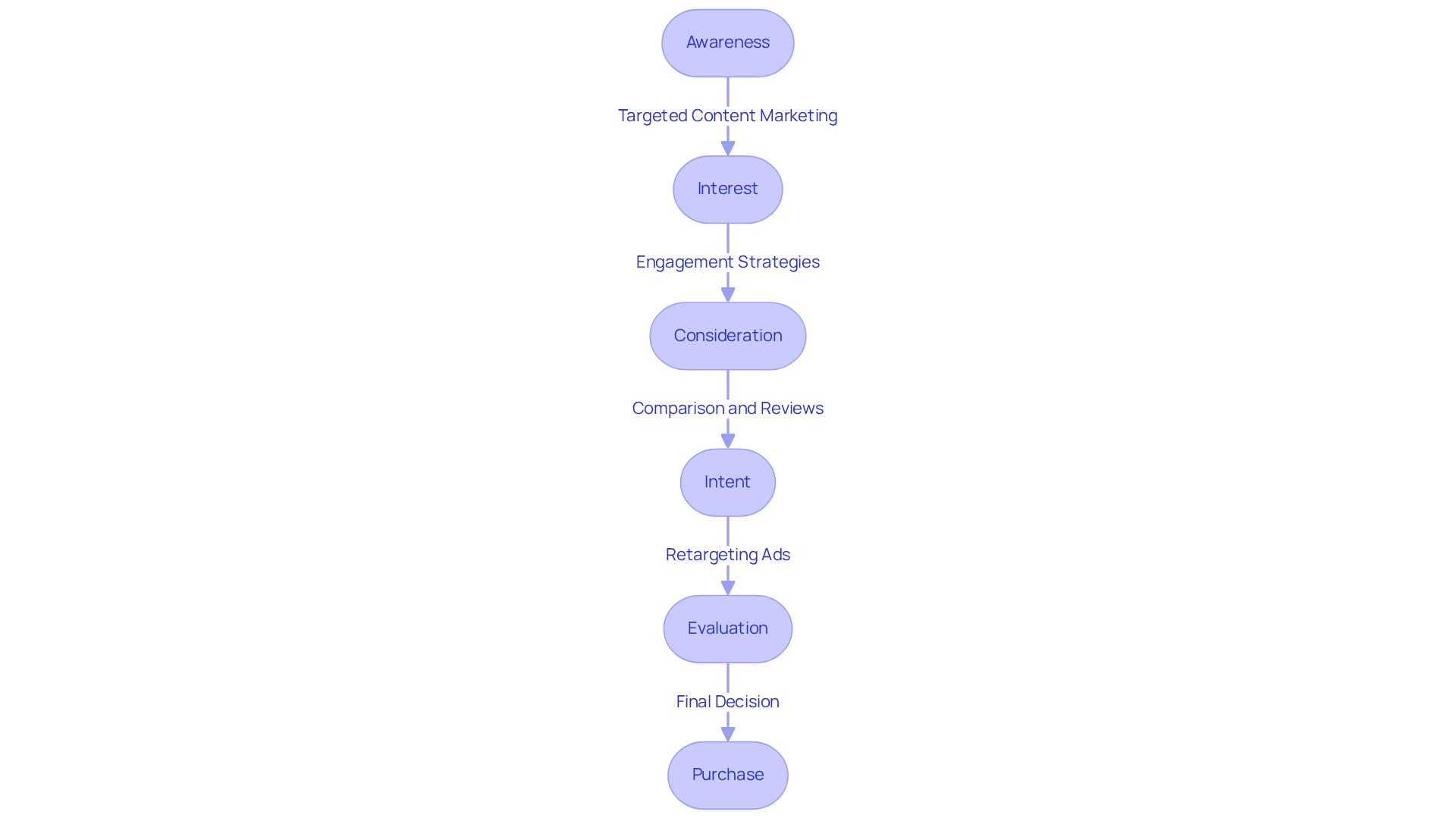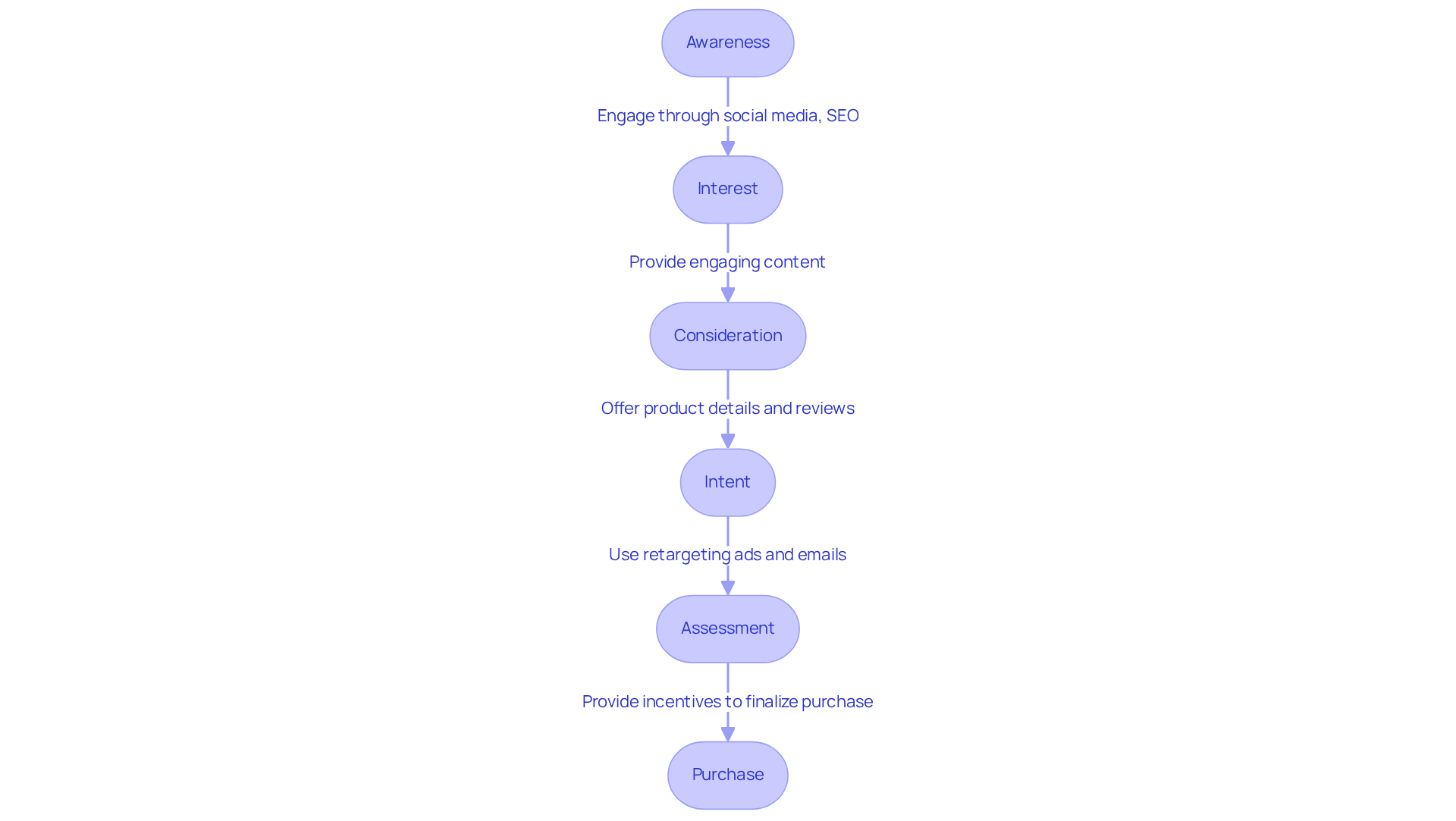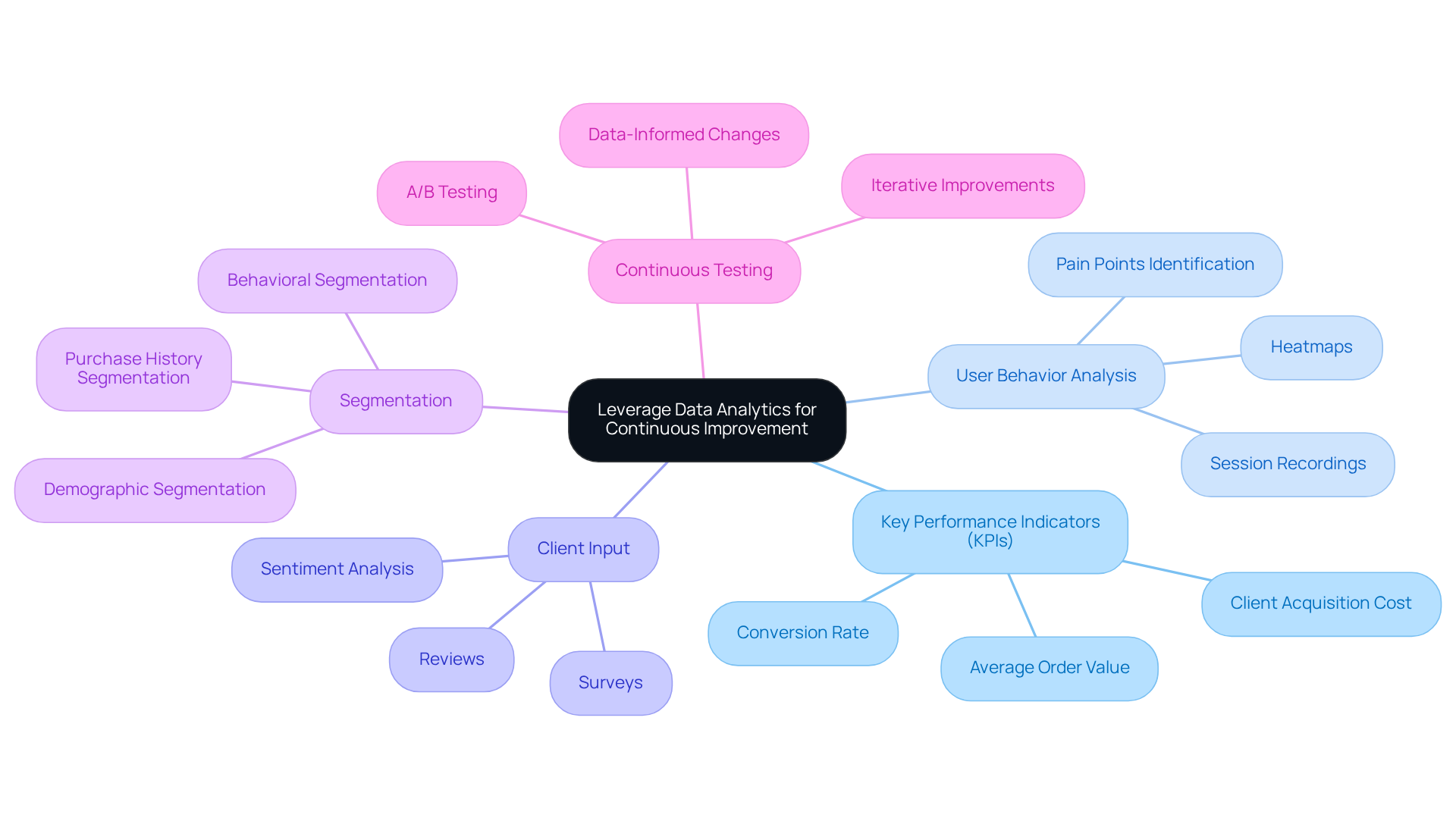
Overview
The article asserts that mastering conversion funnel optimization is essential for the success of direct-to-consumer (DTC) brands. It delineates the crucial stages of the funnel and presents effective strategies tailored for each phase. By leveraging targeted marketing, data analytics, and customer engagement techniques, brands can significantly enhance each stage—from awareness to purchase—thereby driving conversions and fostering long-term profitability. This strategic approach not only captures attention but also builds interest in the critical role of optimization in achieving sustainable success.
Introduction
Mastering the intricacies of the conversion funnel is vital for direct-to-consumer (DTC) brands striving for success in an increasingly competitive marketplace. By expertly navigating each stage of this framework—from initial awareness to the final purchase—brands can effectively shepherd potential customers through their buying journey. This approach minimizes drop-off rates and maximizes conversions.
Yet, with a plethora of strategies at their disposal, how can brands discern which methods will yield the most favorable results? Engaging with proven optimization techniques and leveraging data-driven insights can illuminate the path to unlocking sustainable growth and profitability within the dynamic realm of DTC marketing.
Understand the Conversion Funnel Framework
The conversion funnel model encompasses various phases that illustrate the journey a client undertakes from the initial discovery of a label to the completion of a purchase. This model typically includes stages such as:
- Awareness
- Interest
- Consideration
- Intent
- Evaluation
- Purchase
Understanding this framework empowers companies to pinpoint where potential clients disengage and to devise strategies that guide them through each phase. For instance, a company might leverage targeted content marketing to enhance awareness and interest, while retargeting ads can effectively re-engage users who have shown intent but have not yet converted. By mapping the client journey, brands can formulate a cohesive and effective marketing strategy that resonates with consumer behavior.
Parah Group, a leader in conversion funnel optimization, underscores the significance of optimizing each stage of the funnel to foster sustainable growth and profitability. Their approach is rooted in data-driven decisions that elevate response rates while minimizing client acquisition costs. Moreover, Parah Group's stringent qualifications, which include a minimum of 100,000 website visitors monthly and 2,000 successful outcomes, ensure their capability to conduct split tests and enhance performance effectively. The onboarding process initiates with a dedicated call aimed at establishing a roadmap for success. Brands must consistently evaluate their metrics to confirm they are effectively guiding clients toward completion, making adjustments as necessary based on data insights and user feedback. With Parah Group's expertise, DTC brands can implement strategies that pave the way for .

Identify Key Stages of the Conversion Funnel
The sales funnel comprises several essential phases that lead prospective clients from initial awareness to final acquisition. Understanding and optimizing each stage is crucial for driving conversions through conversion funnel optimization.
- Awareness: This initial stage is where potential clients first come across the label. Effective strategies include leveraging social media marketing, forming influencer partnerships, and optimizing for SEO to enhance visibility. With 83% of marketers recognizing social media as their main , companies can greatly enhance visibility through targeted campaigns.
- Interest: Once awareness is established, individuals begin to express interest in the brand's offerings. Engaging content, such as informative blog posts and captivating videos, plays a vital role in nurturing this interest. Data shows that user-generated content can drive 28% more engagement than branded content, making it a powerful tool in this stage.
- Consideration: At this point, clients are actively assessing their options. Offering thorough product details, genuine user reviews, and in-depth comparison guides can assist in shaping their decision-making process. Brands that effectively convey value and differentiate their offerings are more likely to convert interested clients.
- Intent: This stage indicates a strong likelihood of purchase. To take advantage of this intent, companies should deploy retargeting advertisements and tailored email campaigns that connect with the individual's prior interactions. Studies show that individuals who interact with brands on social media spend 35-40% more on their products, emphasizing the significance of prompt and pertinent communication.
- Assessment: As clients finalize their decisions, providing incentives like discounts or complimentary shipping can be crucial in securing the agreement. Brands that generate a feeling of urgency or exclusivity can further encourage buyers to finalize their purchases.
- Purchase: The final stage is where the transaction occurs. Ensuring a seamless and user-friendly checkout process is critical to minimizing cart abandonment. Brands that simplify this experience can significantly improve success rates.
By clearly outlining these phases and applying focused strategies, companies can efficiently achieve conversion funnel optimization to meet customer requirements and enhance outcomes throughout the entire process.

Implement Proven Strategies for Funnel Optimization
To optimize the conversion funnel, brands can implement several impactful strategies:
- [A/B Testing](https://parahgroup.com): Regularly test different versions of landing pages, call-to-action buttons, and product descriptions to determine which variations yield the highest success rates. A/B testing has been shown to achieve performance increases of up to 24%, significantly influencing overall sales outcomes.
- Personalization: Leverage data analytics to create tailored shopping experiences. Customized suggestions based on browsing history can enhance user engagement, with research indicating that personalized experiences can lead to a 10% increase in success rates.
- Streamlined Checkout Process: Simplify the checkout process by reducing the number of steps necessary to complete a purchase. Implementing guest checkout options can alleviate friction, addressing the nearly 70% cart abandonment rate observed across industries.
- Engaging Content: Produce high-quality content that resonates with the target audience. This includes informative blog posts, captivating videos, and interactive quizzes that sustain user interest. Landing pages featuring videos can enhance engagement rates by 86%, underscoring the significance of compelling content.
- Social Proof: Utilize client testimonials, reviews, and case studies to build trust and credibility. Showcasing social proof can significantly influence purchasing decisions, as evidenced by a 5% increase in transactions when social proof is presented on landing pages.
- Retargeting Campaigns: Deploy retargeting ads to re-engage users who have visited the site but did not convert. These ads serve as reminders of products they explored, encouraging them to return and complete their purchases.
By implementing these strategies, brands can effectively enhance their sales process through conversion funnel optimization, resulting in increased sales and customer loyalty.

Leverage Data Analytics for Continuous Improvement
is pivotal in the ongoing enhancement of the sales process. Brands must concentrate on several key aspects:
- Key Performance Indicators (KPIs): It is crucial to identify and track relevant KPIs such as conversion rate, average order value, and client acquisition cost. These metrics provide valuable insights into the efficiency of the sales process.
- User Behavior Analysis: Employ tools like heatmaps and session recordings to gain a comprehensive understanding of user interactions with the website. This data can uncover pain points and identify areas ripe for improvement.
- Client Input: Regularly collect and analyze client feedback through surveys and reviews. Understanding client sentiments can guide necessary modifications to the sales process.
- Segmentation: Segment users based on behavior, demographics, and purchase history. This strategy enables more targeted marketing efforts and fosters personalized experiences.
- Continuous Testing: Cultivate a culture of continuous testing and iteration. Consistently assess the effectiveness of various strategies and implement data-informed changes to enhance the sales process.
By leveraging data analytics, brands can ensure their conversion funnel optimization remains effective and responsive to evolving customer needs, ultimately driving sustained growth and profitability.

Conclusion
Mastering conversion funnel optimization is essential for the success of Direct-to-Consumer (DTC) brands, enabling them to effectively guide potential customers through their purchasing journey. By understanding the various stages of the conversion funnel—from awareness to purchase—brands can craft targeted strategies that address consumer needs at each phase, ultimately driving higher conversion rates and fostering long-term loyalty.
The article highlights the importance of each funnel stage, emphasizing strategies such as:
- A/B testing
- Personalization
- Engaging content
to enhance user experience. It underscores the necessity of leveraging data analytics to continuously monitor performance and adapt marketing efforts. By focusing on key aspects like user behavior analysis and client feedback, brands can refine their approaches, ensuring they remain responsive to changing consumer preferences.
In conclusion, the significance of conversion funnel optimization cannot be overstated for DTC brands striving for growth and profitability. Embracing a data-driven mindset and implementing proven strategies will not only improve sales outcomes but also strengthen customer relationships. As the market continues to evolve, brands must remain vigilant and proactive in optimizing their conversion funnels, thereby securing their place in an increasingly competitive landscape.
Frequently Asked Questions
What is the conversion funnel framework?
The conversion funnel framework illustrates the journey a client takes from discovering a brand to completing a purchase. It typically includes stages such as Awareness, Interest, Consideration, Intent, Evaluation, and Purchase.
Why is understanding the conversion funnel important for companies?
Understanding the conversion funnel helps companies identify where potential clients disengage and allows them to develop strategies to guide clients through each phase, ultimately improving conversion rates.
What strategies can companies use to enhance each stage of the conversion funnel?
Companies can use targeted content marketing to boost Awareness and Interest, while retargeting ads can re-engage users who have shown Intent but have not yet converted.
Who is Parah Group and what do they specialize in?
Parah Group is a leader in conversion funnel optimization, focusing on optimizing each stage of the funnel to promote sustainable growth and profitability through data-driven decisions.
What qualifications does Parah Group require for effective performance?
Parah Group requires a minimum of 100,000 website visitors monthly and 2,000 successful outcomes to ensure their capability to conduct split tests and enhance performance effectively.
What does the onboarding process with Parah Group involve?
The onboarding process begins with a dedicated call aimed at establishing a roadmap for success, ensuring that brands have a clear strategy moving forward.
How should brands evaluate their progress in the conversion funnel?
Brands should consistently evaluate their metrics to ensure they are effectively guiding clients toward completion and make necessary adjustments based on data insights and user feedback.
What is the ultimate goal of implementing strategies in the conversion funnel?
The ultimate goal is to pave the way for long-term success in sales endeavors for direct-to-consumer (DTC) brands.
FAQs











